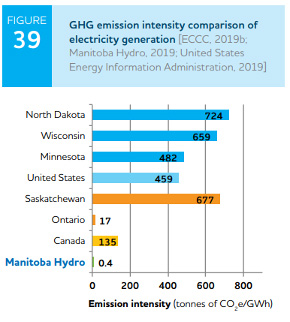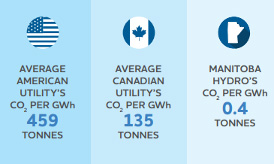Moving to net zero: Manitoba Hydro ready to meet Canadian federal guidelines
Manitoba’s electricity system already one of the lowest GHG-intensive grids in Canada
With abundant clean, renewable hydropower, Manitoba is poised to lead Canada’s fight against climate change through the reduction of greenhouse gas (GHG) emissions.
The Government of Canada released a strengthened climate strategy just before the new year. The 80-page document, A Healthy Environment and a Healthy Economy, lays out a plan to meet or exceed Canada’s 2030 Paris Agreement emissions reduction target (a 30 per cent reduction in GHG emissions from 2005 levels) and establish the building blocks to get to net-zero by 2050.
“This is the most significant climate change strategy ever introduced by a federal government in Canada,” said Kristel Arnold, Energy Policy Officer for Manitoba Hydro.
“It includes a plan to increase the federal backstop GHG price to $170 per tonne CO2e by 2030. It also proposes aligning vehicle emissions standards with the most stringent standards in the U.S. at either the state or federal level.”
Though it hasn’t always been intentional – until recently the low emissions from hydropower generation were more a byproduct of development than a strategic choice – Manitoba’s power infrastructure has always been largely GHG-free, with most generating stations leveraging the natural flow of water in the province as fuel instead of higher-emissions power sources like fossil fuels.
“At Manitoba Hydro, we’re proud of our climate change performance,” said Lorne Midford, Vice-President of Asset Planning & Delivery for Manitoba Hydro. “The development of hydropower over the past 110 years has put us head and shoulders ahead of other regions in having a virtually non-emitting electricity system.”
Under proposed legislation introduced in Canadian Parliament on November 19, national targets for the reduction of GHG emissions would be set for 2030, 2035, 2040, and 2045, with the goal of national net-zero GHG emissions by 2050. GHG emission reduction plans, progress reports, and assessment reports would need to be tabled in Parliament for each year to help ensure transparency in meeting these targets.
Lowest GHG emissions of electrical utilities throughout Canada
Using the latest national figures for 2019, Manitoba Hydro’s electrical operations are among the least GHG-intensive of all electrical utilities in Canada, emitting approximately 0.88 tonnes of GHGs per gigawatt-hour (t/GWh) of power generated. For context, the 2018 GHG emission intensity of electrical generation across Canada as a whole was approximately 120 t/GWh, with Ontario at 29 t/GWh and Québec 1.3 t/GWh.

Manitoba Hydro is reducing global emissions by relying as much as possible on renewable resources. Exporting extra electricity to neighbouring provinces and states can help reduce their emissions too and assists in the fight against global climate change.
On a local scale, GHG emissions from Manitoba Hydro’s electricity and natural gas operations are also less than one per cent of total provincial GHG emissions, and the province contributes less than three per cent of Canada’s national GHG emissions. Total GHG emissions from Manitoba Hydro’s operations in 2019 were 0.11 megatonnes. This equates to Manitoba Hydro contributing less than 0.1 per cent of national electrical generation emissions.

Manitoba Hydro’s primarily run-of-river hydropower is among the cleanest energy in Canada.
Adding more clean energy to the grid
The first unit at the Keeyask Generating Station went into commercial service on February 16, 2021 adding another source of clean, renewable electricity to Manitoba Hydro’s energy supply.
“First power from Keeyask builds on Manitoba Hydro’s enviable position in the low carbon world of the future,” said Jay Grewal, Manitoba Hydro’s President & CEO. “Nearly 98 per cent of our electricity is already generated using clean, renewable, and virtually carbon-free hydropower – a huge advantage for our province as North America moves to reduce carbon emissions.”

When complete, the Keeyask Generating Station will have seven units in service producing an average of 4,400 gigawatt hours of electricity annually, making it the fourth largest generating station in Manitoba. The energy produced by Keeyask will help to meet the utility’s current export commitments and domestic demand. The Keeyask Generating Station is a collaborative effort between Manitoba Hydro and four partner First Nations – Tataskweyak Cree Nation, War Lake First Nation, York Factory First Nation and Fox Lake Cree Nation – known collectively as the Keeyask Hydropower Limited Partnership.
Manitoba Hydro displaces more than it produces
Midford said when the estimated GHG emissions displaced in jurisdictions outside the province are taken into account, Manitoba Hydro’s electricity exports (where those exports displace fossil-fueled electricity generation), help displace more GHG emissions than the utility produces.
The total amount displaced: about seven megatonnes CO2e annually.
“While reductions are counted in the regions where they occur, it’s important to remember that from the perspective of the earth’s atmosphere, it doesn’t matter where GHG reductions are located,” Midford said. “From that point of view, we’re making a meaningful difference in helping mitigate global climate change.”

Like the eagle, climate change knows no borders. By continuing to work together on this urgent crisis, we will be able to avoid the worst effects of climate change and build a healthier and cleaner future. This photo of a soaring eagle was taken by Manitoba Hydro’s Donald Pawluk during spring thaw at the Wuskwatim Generating Station forebay. Located on the Burntwood River in northern Manitoba, the station was developed by the Wuskwatim Power Ltd. Partnership, a venture between the Nisichawayasihk Cree Nation and Manitoba Hydro.
Working toward further improvement
Climate change has been on Manitoba Hydro’s radar since the 1980s. The utility’s strategy to respond to climate change includes further reducing global GHG emissions by enhancing the generation output of existing generating stations and continually looking at how wind, solar and a wide array of emerging electricity technologies such as batteries and bioenergy systems may fit in future energy supply planning.
As the energy landscape evolves, Manitoba Hydro also continues to monitor and plan for trends in the electrification of transportation, as well as the adoption of heat pumps, geothermal systems and other energy-related technologies. The corporation also periodically publishes a Climate Change Report to provide insight into its response to climate change, with the most recent in 2020.
Sharing expertise to affect change
Manitoba Hydro staff participate in climate change working groups to share ideas with professionals both inside and outside the energy industry in Canada and the U.S. on topics related to physical climate impacts and adaptation in addition to GHG reduction strategies. For more than 25 years, the utility has lent technical and market expertise to support the development, evaluation, and implementation of standards, regulations, legislation, voluntary programs and markets that aim to reduce GHG emissions.
“It’s all part of our efforts to help ensure we continue to be a climate change leader in the utility industry as we move towards a net zero world,” said Midford.
Read more about Manitoba Hydro’s efforts to reduce GHG emissions.
Manitoba Hydro’s full 96-page Climate Change Report (PDF, 9.9 MB).

Manitoba Hydro actively supports the development of policies that reduce emissions and help mitigate climate change. Our support also includes openly sharing the technical knowledge and experience we’ve gained over decades.
